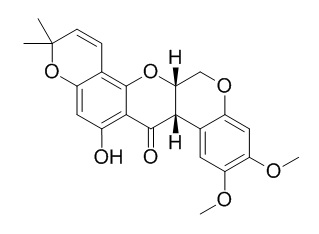Alpha-Toxicarol
Alpha-Toxicarol exhibits a marked inhibitory effect on mouse skin tumor promotion in an in vivo two-stage carcinogenesis test.
Inquire / Order:
manager@chemfaces.com
Technical Inquiries:
service@chemfaces.com
Tel:
+86-27-84237783
Fax:
+86-27-84254680
Address:
1 Building, No. 83, CheCheng Rd., Wuhan Economic and Technological Development Zone, Wuhan, Hubei 430056, PRC
Providing storage is as stated on the product vial and the vial is kept tightly sealed, the product can be stored for up to
24 months(2-8C).
Wherever possible, you should prepare and use solutions on the same day. However, if you need to make up stock solutions in advance, we recommend that you store the solution as aliquots in tightly sealed vials at -20C. Generally, these will be useable for up to two weeks. Before use, and prior to opening the vial we recommend that you allow your product to equilibrate to room temperature for at least 1 hour.
Need more advice on solubility, usage and handling? Please email to: service@chemfaces.com
The packaging of the product may have turned upside down during transportation, resulting in the natural compounds adhering to the neck or cap of the vial. take the vial out of its packaging and gently shake to let the compounds fall to the bottom of the vial. for liquid products, centrifuge at 200-500 RPM to gather the liquid at the bottom of the vial. try to avoid loss or contamination during handling.
Asian J Beauty Cosmetol2019, 17(3):287-294
Research Square2021, 10.21203.
J Pharm Biomed Anal.2024, 251:116444.
Mol Microbiol.2019, 112(1):317-332
RSC Adv.2023, 13(9):6317-6326.
Biol Pharm Bull.2023, 46(2):245-256.
Neurochem Res.2021, s11064-021-03449-0
Molecules.2019, 24(12):E2286
Biomol Ther (Seoul).2023, 31(1):40-47.
Natural Product Communications2020, doi: 10.1177.
Related and Featured Products
J Nat Prod. 2003 Sep;66(9):1166-70.
Potential cncer chemopreventive flavonoids from the stems of Tephrosia toxicaria.[Pubmed:
14510590 ]
METHODS AND RESULTS:
A new butenylflavanone, (2S)-5-hydroxy-7-methoxy-8-[(E)-3-oxo-1-butenyl]flavanone (1), and a new rotenoid, 4',5'-dihydro-11,5'-dihydroxy-4'-methoxytephrosin (2), as well as three active flavonoids of previously known structure, isoliquiritigenin (3), genistein (4), and chrysoeriol (5), along with nine known inactive compounds, Alpha-Toxicarol (6), sumatrol, 6a,12a-dehydro-Alpha-Toxicarol, 11-hydroxytephrosin, obovatin, marmesin, lupenone, benzyl benzoate, and benzyl trans-cinnamate, were isolated from an ethyl acetate-soluble extract of the stems of Tephrosia toxicaria, using a bioassay based on the induction of quinone reductase (QR) in cultured Hepa 1c1c7 mouse hepatoma cells to monitor chromatographic fractionation. The structures of compounds 1 and 2 were elucidated by spectroscopic data interpretation.
CONCLUSIONS:
All isolates were evaluated for their potential cancer chemopreventive properties utilizing an in vitro assay to determine quinone reductase induction. Selected compounds were tested in a mouse mammary organ culture assay to evaluate the inhibition of 7,12-dimethylbenz[a]anthracene (DMBA)-induced preneoplastic lesions.
J Agric Food Chem. 2012 Oct 10;60(40):10055-63.
Highly variable insect control efficacy of Tephrosia vogelii chemotypes.[Pubmed:
22970736 ]
Tephrosia vogelii has been used for generations as a pest control material in Africa.
METHODS AND RESULTS:
Recently, two chemotypes have been reported based on the occurrence (chemotype 1) or absence (chemotype 2) of rotenoids. This could have an impact on the efficacy and reliability of this material for pest control. We report that chemotype 2 has no pesticidal activity against Callosobruchus maculatus Fabricius (family Chrysomelidae) and that this is associated with the absence of rotenoids.
CONCLUSIONS:
We present a first report of the comparative biological activity of deguelin, tephrosin, α-toxicarol, and sarcolobine and show that not all rotenoids are equally effective. Tephrosin was less toxic than deguelin which was less active than rotenone, while obovatin 5-methyl ether, the major flavonoid in chemotype 2 was inactive. We also report that in chemotype 1 the occurrence of rotenoids shows substantial seasonal variation.
Planta Med. 2004 Jun;70(6):585-8.
Cancer chemopreventive activity of rotenoids from Derris trifoliata.[Pubmed:
15229812 ]
A study of the chemical constituents of the stems of Derris trifoliata Lour. (Leguminosae) led to the isolation and identification of one new rotenoid, 6aalpha,12aalpha-12a-hydroxyelliptone ( 3), together with five other known rotenoids.
METHODS AND RESULTS:
In a search for novel cancer chemopreventive agents (anti-tumor promoters), we carried out a primary screening of five of the rotenoids isolated from the plant for their inhibitory effects on Epstein-Barr virus early antigen (EBV-EA) activation induced by 12- O-tetradecanoylphorbol 13-acetate (TPA) in Raji cells. The inhibitory activity of 3 was found to be equivalent to that of beta-carotene without any cytotoxicity.
CONCLUSIONS:
Deguelin ( 4) and Alpha-Toxicarol ( 5) exhibited a marked inhibitory effect on mouse skin tumor promotion in an in vivo two-stage carcinogenesis test. This investigation indicated that rotenoids might be valuable anti-tumor promoters.



